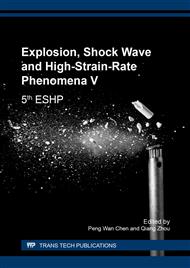[1]
M. Iyer, V. Gavini, T.M. Pollock, Energetics and nucleation of point defects in aluminum under extreme tensile hydrostatic stresses, Phys. Rev. B 89 (2014) 014108.
DOI: 10.1103/physrevb.89.014108
Google Scholar
[2]
R.A. Lebensohn, J.P. Escobedo, E.K. Cerreta, D. Dennis-Koller, C.A. Bronkhorst, J.F. Bingert, Modeling void growth in polycrystalline materials, Acta Mater. 61 (2013) 6918-6932.
DOI: 10.1016/j.actamat.2013.08.004
Google Scholar
[3]
Y. Fan, A. Kushima, S. Yip, B. Yildiz, Mechanism of void nucleation and growth in bcc Fe: atomistic simulations at experimental time scales, Phys. Rev. Lett. 106 (2011) 125501.
DOI: 10.1103/physrevlett.106.125501
Google Scholar
[4]
Q.Y. Chen, K.X. Liu, A void growth model considering the Bauschinger effect and its application to spall fracture, Chin. Phys. Lett. 28 (2011) 064602.
DOI: 10.1088/0256-307x/28/6/064602
Google Scholar
[5]
J.L. Shao, P. Wang, A.M. He, R. Zhang, C.S. Qin, Spall strength of aluminium single crystals under high strain rates: molecular dynamics study, J. Appl. Phys. 114 (2013) 173501.
DOI: 10.1063/1.4828709
Google Scholar
[6]
K. Baumung, H. Bluhm, G.I. Kanel, G. Muller, S.V. Razorenov, J. Singer, A.V. Utkin, Tensile strength of five metals and alloys in the nanosecond load duration range at normal and elevated temperatures, Int. J. Impact Eng. 25 (2001) 631-639.
DOI: 10.1016/s0734-743x(01)00004-5
Google Scholar
[7]
G.I. Kanel, K. Baumung, J. Singer, S.V. Razorenov, Dynamic strength of aluminum single crystals at melting, Appl. Phys. Lett. 76 (2000) 3230.
DOI: 10.1063/1.126590
Google Scholar
[8]
X. Chen, J.R. Asay, S.K. Dwivedi, D.P. Field, Spall behavior of aluminum with varying microstructures, J. Appl. Phys. 99 (2006) 023528.
DOI: 10.1063/1.2165409
Google Scholar
[9]
H. Peng, P. Li, X.Y. Pei, H.L. He, M.L. Qi, Measurement of dynamic damaged materials by white light axial chromatic aberration, Opt. Pre. Eng. 21 (2013) 20-26.
Google Scholar
[10]
M.L. Qi, S. Zhong, D. Fan, C. Luo, H.L. He, Microscopic characteristics of damage evolution in ultrapure aluminum under tensile loading, Chin. Phys. Lett. 28 (2011) 016103.
DOI: 10.1088/0256-307x/28/1/016103
Google Scholar
[11]
L. Wayne, K. Krishnan, S. DiGiacomo, N. Kovvali, P. Peralta, S.N. Luo, S. Greenfield, D. Byler, D. Paisley, K.J. McClellan, A. Koskelo, R. Dickerson, Statistics of weak grain boundaries for spall damage in polycrystalline copper, Scr. Mater. 63 (2010).
DOI: 10.1016/j.scriptamat.2010.08.003
Google Scholar
[12]
P. Peralta, S. DiGiacomo, S. Hashemian, S.N. Luo, D. Paisley, R. Dickerson, E. Loomis, D. Byler, K.J. McClellan, H. D'Armas, Characterization of incipient spall damage in shocked copper multicrystals, Int. J. Damage Mech. 18 (2008) 393-413.
DOI: 10.1177/1056789508097550
Google Scholar
[13]
J. Bontaz-Carion, Y. Pellegrini, X-ray microtomography analysis of dynamic damage in tantalum, Adv. Eng. Mater. 8 (2006) 480-486.
DOI: 10.1002/adem.200600058
Google Scholar
[14]
L. Seaman, D.R. Curran, R.C. Crewdson, Transformation of observed crack traces on a section to true crack density for fracture calculations, J. Appl. Phys. 49 (1978) 5221-5229.
DOI: 10.1063/1.324419
Google Scholar
[15]
D.R. Curran, L. Seaman, D.A. Shockey, Dynamic failure of solids, Phys. Rep. 147 (1987) 253-388.
Google Scholar
[16]
A.L. Gurson, Continuum theory of ductile rupture by void nucleation and growth: part I—yield criteria and flow rules for porous ductile media, J. Eng. Mater. Tech. 99 (1977) 2-15.
DOI: 10.2172/7351470
Google Scholar
[17]
J.N. Johnson, Ductile fracture and spallation in solids, J. Appl. Phys. 52 (1980) 2812-2825.
Google Scholar
[18]
A.K. Zurek, W.R. Thissell, D.L. Tonks, R. Hixson, F. Addessio, Quantification of damage evolution for a micromechanical model of ductile fracture in spallation of tantalum, J. Physique IV 07 (1997) C3-903-C3-908.
DOI: 10.1051/jp4:19973152
Google Scholar
[19]
M.L. Qi, S. Zhong, H.L. He, D. Fan, L. Zhao, Effect of grain size and arrangement on dynamic damage evolution of ductile metal, Chin. Phys. B 22 (2013) 046203.
DOI: 10.1088/1674-1056/22/4/046203
Google Scholar
[20]
H. Peng, P. Li, X.Y. Pei, H.L. He, H.P. Cheng, M.L. Qi, Experimental study of the spatial discontinuity of dynamic damage evolution, Acta Phys. Sin. 62 (2013) 226201.
Google Scholar
[21]
A. Strachan, T. Çağın, W. Goddard, Critical behavior in spallation failure of metals. Phys. Rev. B 63 (2001) 060103.
DOI: 10.1103/physrevb.63.060103
Google Scholar


